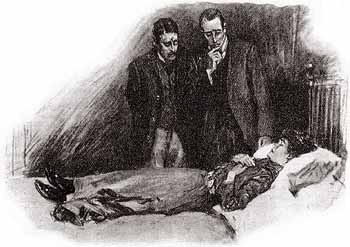A Scion Society of The Baker Street Irregulars

Data! Data! Data! – The Devil’s Foot
“‘Data! Data! Data!‘ he cried impatiently. ‘I can’t make bricks without clay.'”
– The Adventures of The Copper Beeches (COPP)

This column is composed of material (Data!) developed for a short course called Appreciating Sherlock Holmes that I teach twice a year in the Community Education Life Enrichment Program for a local community college. It is composed of “points of information” that are common to many / most / all of the 60 Canonical stories.
The information here has been researched by me or borrowed / stolen from many efforts of other Sherlockians.
HERE GOES This month’s story The Adventure of the Devil’s Foot
 CHRISTOPHER MORLEY SAID . . .
CHRISTOPHER MORLEY SAID . . .
“In some moods Holmes believed this story of the Cornish Horror the strangest case he ever handled. It happened when he and Watson were vacationing in the unusual landscape of Cornwall. In their investigation both were nearly overcome by the strange effects of the West African drug, radix pedis diaboli or the devil’s foot root.”
 DUMMIES SHORT SUMMARY (From Sherlock Holmes for Dummies by Steven Doyle & David Crowder)
DUMMIES SHORT SUMMARY (From Sherlock Holmes for Dummies by Steven Doyle & David Crowder)
“When an entire family is driven insane, the village priest is sure that it’s the work of the devil. Sherlock Holmes isn’t so sure.”
PUBLISHING HISTORY
- This is the 43rd of the 60 stories published
- In England, it was published in The Strand Magazine, in December, 1910
- In the U.S., it was published in the American issues of The Strand Magazine in January & February, 1911
- It was part of the His Last Bow collection in 1917 by John Murray, London and George H. Doran, New York 1917
- The British illustrator was Gilbert Holiday
HOW MANY WORDS?
According to C. E. Lauderback, 1960 – – found on the SHERLOCKIAN.NET website started by Chris Redmond at 10,055 words DEVI has the 52nd most words (#1 is VEIL – 4,499, #56 if NAVL – 12,701)
THE BEST OF SHERLOCK HOLMES (How do Sherlockians rate this story?)
1927 – Arthur Conan Doyle had it 9th on his list of 12 favorites
1944 – The Baker Street Irregulars voted it as 12th on their top 12 favorites
1999 – The Baker Street Irregulars voted it 15th of the 56 short stories
1999 – The Sherlock Holmes Society of London voted it 12th of 56 short stories
CLASSIFYING THE CASE (From the Wandering Gipsies of Grimpen Mire of Decatur, Alabama)
This case is one of 23 classified as a MURDER where the perpetrator was either killed, arrested, or otherwise satisfactorily handled. And one of 4 where Holmes let the perpetrator go free. The others were ABBE, BOSC, and VEIL.
CHRONOLOGICALLY SPEAKING
Doyle was often very vague about stating WHEN the tale took place and included few contemporary references to help. Whether this was done intentionally or unthinkingly, the dating of events in the Canon is a very popular pastime pursued by several of our “scholars” researching and justifying their results to no end. We will again default to William Baring-Gould’s dating of Tuesday, March 16 to Saturday, March 20, 1897. This means that Holmes is 43 and Watson 45.
WHAT ELSE HAPPENED IN YEAR 1897?
It is always interesting to see what else in happening at the same time as the stories.


- Victoria’s Diamond Jubilee
- Uprising on India’s Northwest Frontier.
- First Women’s Institute in the world; established at Stoney Creek, Canada.
- Sir Henry Tate presents the Tate Gallery to the nation.
- Report of Royal Commission (Eversley) on agricultural depression.
- Employers’ Liability Act: responsibility for injuries to and compensation of employees injured at work. Nowadays in the form of claims management services.
- Royal Automobile Club, London.
- Trained nurses only to be employed in hospitals.
- Dreyfus affair.
- Universal suffrage introduced in Austria.
- H.G. Wells publishes The Invisible Man.
- Roistand publishes Cyrano de Bergerac.
- Paul Dukas debuts The Sorcerer’s Apprentice.
- Gauguin paints Girls Bathing in Tahiti.
- Aspirin marketed.
- McCreary patents an air-washer intended to purify air in a building; beginning of air-conditioning.
- Diesel engine invented.
- Sir Ronald Ross, bacteriologist, identifies the causes of malaria and studies the disease.
- Beginning of Monotype system of typesetting.
- A. Andre is killed attempting to explore the polar regions in a free-flying balloon.
HOLMES AND WATSON – PERSONAL INFO
Living arrangements are not stated but they probably were not together at 221B since Holmes telegraphed Watson.
DRAMATIS PERSONAE
- MR. ROUNDHAY, vicar at Tredannick Wollas parish, Cornwall.
- MORTIMER TREGENNIS, a boarder at the vicarage.
- OWEN TREGENNIS, brother to Mortimer
- GEORGE TREGENNIS, another brother
- BRENDA TREGENNIS, a sister and secret lover of…
- LEON STERNDALE, noted African explorer.
- MOORE AGAR, prominent Harley Street physician who prescribed a complete rest for Holmes.
- RICHARDS, local medical practitioner of Tredannick Wollas.
- PORTER, maid to the Tregennis household.
- HELSTON, a lunatic asylum where Owen and George were taken.
“QUOTABLE SHERLOCK”
- Holmes to Watson – “The Cornish horror – Strangest case I have handled.”
- Holmes to Mortimer Tregennis – “I fear that if the matter is beyond humanity it is certainly beyond me. Yet we must exhaust all natural explanations before we fall back upon a theory as this.”
- Holmes to Watson – “I think, Watson, that I shall resume that course of tobacco-poisoning which you have so often so justly condemned.”
- Holmes to Watson – “To let the brain work without sufficient material is like racing an engine. It racks itself to pieces.”
- Holmes to Watson – “Let us get a firm grip of the very little we do know, so that when fresh facts arise we may be ready to fit them into their places.”
- An exchange between Holmes and Sterndale – “You are very inquisitive, Mr. Holmes.”
- “It is my business.”
- Holmes to Watson – “It is not for me, my dear Watson, to stand in the way of the official police force. I leave them all the evidence which I have found,”
- Holmes to Sterndale – “Surely the clearest proof of it is that, knowing what I know, I have sent for you and not for the police.”
- Holmes to Sterndale – “I have heard your reasons and regard them as unconvincing and inadequate. We will pass that.”
- An exchange between Holmes and Sterndale
Sterndale “How do you know that?’
Holmes “I followed you.”
Sterndale “I saw no one.”
Holmes “That is what you may expect to see when I follow you.”
- Holmes to Watson – “Some fumes which are not poisonous would be a welcome change.”
- Holmes to Watson – “I have never loved, Watson, but if I did and the woman I loved had met such an end, I might have done as our lawless lion-hunter has done.”
HOLMES’ FEE
There is no mention of a fee in the story. As only person left that could have paid was Sterndale, and such a proposition would have been unthinkable.
SHERLOCK ON THE BIG SCREEN & THE LITTLE SCREEN
- 1921 – The Devil’s Foot with Eille Norwood, which was second in the series and one of only 4 available to the public
- 1965 – The Devil’s Foot with Douglas Wilmer as part of his Sherck Holmes TV series
- 1988 – The Devil’s Foot with Jeremy Brett in his BBC/Granada Sherlock Holmes series
SHERLOCK HOLMES IN DISGUISE
The Master of disguise used the deception of being disguised 14 times in 11 of the 60 stories. None were needed or used in this story.
UNRECORDED CASES (That involved Holmes)
Watson would tease / torture his readers with “I know something you don’t.” Oh my, how Sherlockians love this category. I have in excess of over 150 examples in my collection. Just one “untold tale” in this tale.
- Moore Agar, of Harley Street, whose dramatic introduction to Holmes I may some day recount…
IS THERE A DOCTOR IN THE HOUSE?
Victorian London, in the Holmes’ time, had approximately 1 doctor for every 100 people. 31 of the 60 tales have a doctor in them. This, of course, does not count Holmes’ Boswell. This listing is by Leslie Klinger in the Winter, 2015 edition of the Baker Street Journal. Whether it was Doyle or Watson, a doctor wrote the story.
In this story there were multiple doctors.
- Moore Agar – who prescribed rest for Holmes
- Richards – the treating physician for the Tregennises
- Leon Sterndale – African missionary
FAINTING IN THE CANON (courtesy of Sherlockian Karen Murdock)
Fainting is extremely common in the Canon, appearing, in some form, in 37 of the 60 tales. In 21 cases someone actually faints. In 22 cases someone almost faints. And in 5 cases someone pretends to faint. In this month’s story, Mrs. Porter actually faints. And, as for the doctor responding to the Tergesses, “I could not stand it, and the doctor was as white as a sheet. Indeed, he fell into a chair in a sort of faint, and we nearly had him on our hands as well.”
HOLMES’S PUBLISHED & PROJECTED WORKS
Sherlockians love this topic and are regularly searching for these items. Holmes mentions published or projected works in 11 of the stories. None are referred to in this story
NEWSPAPERS (Real and Fictional)
Though included in only 20 tales some of our more obsessed Sherlockians love this one but none in this one.
ANNOTATED SHERLOCK
The 60 Sherlock Holmes stories used English as spoken in England from the 1880’s until the 1910’s. Some words are foreign to us today and need a “contemporary translation.” Just a few mentions here:
- “ramping” – jumping up and down
- “nitsky” – next to nothing
- “Nihlist” – member of the Russian revolutionary party professing extreme anti-social principals and destruction of political institutions
- “Furies” – three Greek goddesses who used secret strings to punish the crimes of those who escaped public justice
WEAPONS (from A Compendium of Canonical Weaponry by Dettman and Bedford)
So many things can be considered “weapons” that only 2 or 3 tales fail to have at least one. Since this column is running long, here is a list of “weapons” with no explanation. See if you can find them in the story.
- Revolver – Which Dr. Leonard Sterndale used to cover Mortimer Tregennis while preparing the submit the latter to the deadly Devil’s Foot Root.
- Devil’s Foot Root (Radix Pedis Diabole) – An extremely poisonous alkaloid from Africa, which Mortimer Tregennis used to murder his sister (while driving his two brothers mad); which Leon Sterndale, erstwhile lover of Miss Tregennis, used to gain revenge upon Tregennis; and which Holmes very nearly succeeded in poisoning both his self and Watson during an experiment.
 Frank Mentzel, aka Merridew of Abominable Memory, is preparing for his spring class of Appreciating Sherlock Holmes next month and is looking forward to working in his garden when it gets warmer.
Frank Mentzel, aka Merridew of Abominable Memory, is preparing for his spring class of Appreciating Sherlock Holmes next month and is looking forward to working in his garden when it gets warmer.

Sorry, comments are closed for this post.